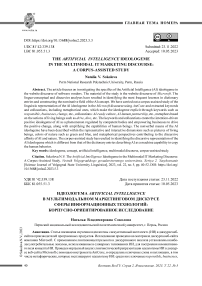The artificial intelligence ideologeme in the multimodal it marketing discourse: a corpus-assisted study
Автор: Sokolova N.V.
Журнал: Вестник Волгоградского государственного университета. Серия 2: Языкознание @jvolsu-linguistics
Рубрика: Главная тема номера
Статья в выпуске: 5 т.22, 2023 года.
Бесплатный доступ
The article focuses on investigating the specifics of the Artificial Intelligence (AI) ideologeme in the website discourse of software vendors. The material of the study is the website discourse of Microsoft . The linguo-conceptual and discursive analyses have resulted in identifying the most frequent lexemes in dictionary entries and constructing the nominative field of the AI concept. We have carried out a corpus-assisted study of the linguistic representation of the AI ideologeme in the Microsoft discourse using AntConc and extracted keywords and collocations, including metaphorical ones, which make the ideologeme explicit through keywords such as responsible , businesses , change , etc., collocations: AI-ready culture , AI-human partnership , etc., metaphors based on the actions of living beings such as drive , dive , etc. The keywords and collocations create the intention-driven positive ideologeme of AI as a phenomenon regulated by competent bodies and empowering businesses to drive the positive change, along with amplifying the capabilities of human beings. The nonverbal means of the AI ideologeme have been described within the representative and interactive dimensions such as pictures of living beings, colors of nature such as green and blue, and metaphorical perspectives contributing to the discursive affinity of AI and nature. The corpus-assisted study has resulted in identifying the discursive representation of the AI ideologeme which is different from that of the dictionary entries describing AI as a machine capability to copy the human behavior.
Ideologeme, concept, artificial intelligence, multimodal discourse, corpus-assisted study
Короткий адрес: https://sciup.org/149145090
IDR: 149145090 | УДК: 81’42:339.138 | DOI: 10.15688/jvolsu2.2023.5.3
Текст научной статьи The artificial intelligence ideologeme in the multimodal it marketing discourse: a corpus-assisted study
DOI:
These days, Artificial Intelligence (hereinafter – AI) is an undeniably important phenomenon. It has an impact on the minds of people concerned with its influence on every aspect of our life.
The term AI is fixed in dictionaries. However, software vendors are making every effort to formulate and make public new principles regulating the use of AI-powered products via their websites transcending an image of AI that may extend far beyond descriptions of its technical features and capabilities.
As compared to dictionaries, such discourses are supposed to play a meaningful role in building a qualitatively different, evolving vision of AI while corpus-assisted studies could contribute to extracting quantitatively significant outcomes. To construct this new image of AI, modern websites employ both verbal and nonverbal means as opposed to dictionaries focusing on linguistic aspects.
First and foremost, this paper aims at investigating the contemporary representation of AI in the multimodal discourse of an IT vendor with the help of the corpus analysis tools and techniques of exploring the nonverbal means. Nevertheless, to make it comprehensive, conventional dictionary concepts of AI must be considered as well.
Theoretical framework
Critical discourse analysis has been in the spotlight of linguistic studies [Chernyavskaya,
2017; 2018] due to its potential to unravel the ideology-driven social practices in the discourse [Fairclough, 2003; Wodak, 201 5]. Norman Fairclough describes discourses as “different perspectives on the world” [Fairclough, 2003, p. 124] emphasizing that they “not only represent the world as it is (or rather is seen to be), they are also projective, imaginary... and tied in to projects to change the world in particular directions” [Fairclough, 2003, p. 124]. This idea is crucial when dealing with discourses since they result from the intention of the locutionary source to create some ‘vision’ or ‘projection’.
Such assumptions fit well into the anthropocentric paradigm as the human factor turns out to be at the center of linguistic analysis of the social activity [Usmonova, 2019, p. 210; Kubryakova, 1995]. This factor is intrinsically intertwined with the persuasive, or perlocutionary, intention [Klushina, 2008] of the locutionary source.
These statements could underpin the studies of corporate discourses projecting images of products and services via websites – the marketing [Borisova, 2016, p. 140] discourse reaching out to customers to convey the idea of value [Scott, 2017] embedded in some product or service. This paper deals with the marketing discourse of the Microsoft website providing insights into the benefits of AI products created by one of the world’s leading software vendors. Such discourses are collections of texts [Borisova, 2016, p. 140; Klushina, 2016, p. 82] delivering some ideologemes [Klushina, 2016].
This paper does not attempt to make a full review of the heterogeneous approaches to the notions of concept and ideologeme defined by a variety of scholars [Bulakhtina, 2009; Lylo, 2017; Samsitova, Tashbulatova, 2015; etc.]. Instead, it relies on the proven cognitive approach [Pavilenis, 1983; Popova, Sternin, 2005] identifying concepts as “information about the actual or possible state of things in the world” [Pavilenis, 1983, pp. 101102]. To investigate dictionary entries, the methodology makes use of the linguistic representation of a specific mental concept – AI in this respect – and provides for identifying its nominative field [Popova, 2006, p. 46] consisting of key nominations, or frequently used lexemes.
As for the ideologeme, it is a more global discourse-related category – the key ideas to be projected through the discourse as a result of fulfilling the intention of the locutionary source [Klushina, 2012]. Such discourse-embedded ideologemes might be imaginary and projective as compared to the concepts fixed in dictionary entries and supposed to reflect the status quo .
Being part and parcel of cognitive linguistics, concepts are existing stereotypes within some society while ideologemes are stereotypes to be embedded in the society [Klushina, 2008]. This understanding makes the analysis of ideologemes a specific part of the communicative stylistics dealing with the intention of the locutionary source to produce some impact on the locutionary target. This paper relies on the definition of ideologemes as the representation of some key values to create a new sustainable ideology for ‘propping up’ the society [Klushina, 2008]. This is a viable way to differentiate between dictionary concepts and discursive ideologemes. It is crucial to focus on dictionary entries first to progress to the vendorspecific discursive representation of AI since it is the cognitive meaning that underlies it all.
The methodology for exploring discursive manifestations of ideologemes also includes investigating nominations and tonality [Klushina, 2008]. This is when quantitative lexicographic and corpus-based discourse studies could add value to the research outcomes based on massive sets of texts and their typical features. Cutting-edge software applications [Shutova, 2018, p. 22] equip linguists with tools for conducting complex corpus-assisted investigations.
AntConc is a freeware corpus analysis toolkit for text analysis and concordancing. It can be used to extract keywords (Keyword List) and collocations (Concordance). Keywords are particularly relevant since they are the most frequently used words that shed the light on the ‘message’ and can be utilized to build the nominative fields of concepts and nominations of ideologemes. As for the concordance feature, the ‘keyword-in-context’, or ‘KWIC’, option enables researchers to set limitations for exploring node word collocations. It also provides for investigating the tonality being evident from concordancing and shaping the semantic prosody [Partington, 1998, p. 68].
Nonverbal means of creating discourses attract an ever-growing interest due to their role and potential [Bi, 2019]. The discourse under study is multimodal. It demonstrates the presence of both verbal, or textual, means and nonverbal ones such as videos, photos, and colors [Kress, Leeuven, 2006; Bateman, 2016].
Relying on the visual grammar methodology [Kress, Leeuwen, 2006], this paper will also focus on images and colors. The scholars [Kress, Leeuwen, 2006] identify the representative and the interactive visual dimensions. The former one is represented by people, places, and things in images while the latter deals with meanings encoded into such images via the gaze of the represented participant, the distance from the viewer, and the angle from which the participant is seen, along with the modality involving colors [Kress, Leeuwen, 2002; Leeuwen, 2013]. Colors play an important role in building multimodal discourses and contribute to a textual cohesion [Kress, Leeuwen, 2002, pp. 348-349].
Material and research methodology
The material under study is the multimodal marketing discourse of Microsoft website in the amount of 29,140 characters and 40 images. To analyze the nominative field of the AI concept, several online dictionary entries have been selected from Cambridge , Dictionary. com , Macmillan , Merriam-Webster , and Oxford in the amount of nearly 9,000 characters.
The research relies on the methodologies spanning the domains of critical discourse analysis [Chernyavskaya, 2017; Fairclough, 2003; Klushina,
2008], marketing discourse [Borisova, 2016], corpus-assisted discourse studies [Chernyavskaya, 2017], concepts and nominative fields within the framework of cognitive linguistics [Popova, Sternin, 2005] and ideologeme-related provisions of the communicative stylistics [Klushina, 2008] as well as visual semiotics [Kress, Leeuwen, 2006].
The anthropocentric paradigm provides for relying on the qualitatively-oriented critical discourse analysis exploring discourses as the reflection of the social life [Fairclough, 2003] by the locutionary source, or an IT vendor in this respect. The quantitative techniques of corpus-assisted studies will be used to build the nominative field of the AI concept fixed in dictionaries and to extract the dominant nominations and KWIC collocations demonstrating the tonality when it comes to the discursive AI ideologeme. The visual grammar [Kress, Leeuwen, 2006] is used to deal with the visual material.
The website discourse is aimed at potential customers who may or may not be IT professionals. The function is not only to inform of IT products but also to convey their value. The comprehensive methodology of the linguo-conceptual and discursive analysis involves the following steps: creating a corpus of dictionary entries to identify the nominative field of the AI concept; creating a corpus of Microsoft website texts highlighting AI benefits; conducting the
AntConc -powered corpus-assisted study to extract keywords (Keyword List), collocations and metaphorical expressions shaping the discourse tonality (Concordance) in line with the intention of the locutionary source; analyzing the nonverbal material in terms of the visual grammar, that is: the representative dimension of portraying living beings and settings and the interactive dimension involving the gaze, distance, and angle from which the participant is seen, along with colors; formulating the Microsoft -specific discursive representations of the AI ideologeme.
Results
The AI concept in dictionaries
This section focuses on identifying the nominative field of the AI concept in the dictionaries since any discursive ideologemes are originally built on information about the actual or possible state of things [Pavilenis, 1983].
The Word List feature of AntConc demonstrates words such as computer(s) , human , capacity , intelligent , mechanical , programmed , behavior , etc. as shown in Figure 1.
AI is linked to computers or other programmed devices, including mechanical ones, which have the capacity to copy the intelligent
Search НН*. О
File View ClusterVN-Gram* Collocates Word List Keyword List
Token*: 162
File Global Settings Tool Preferences Help computers intelligent mechanical programmed intelligence development Clone Result*
Fig. 1. Dictionary entries:
Word List
results
human behavior. Similar definitions are typical of all the dictionaries analyzed:
(1) ...The study and development of computer systems that can copy intelligent human behaviour (Oxford); the use of computer technology to make computers and other machines think and do things in the way that people can (Macmillan); the capability of a machine to imitate intelligent human behavior (Merriam-Webster); the capacity of a computer, robot, or other programmed mechanical device to perform operations and tasks analogous to learning and decision making in humans, as speech recognition or question answering; a computer, robot, or other programmed mechanical device having this humanlike capacity (Dictionary.com).
Some entries also mention the study or the branch of knowledge:
(2) ...The study of how to make computers that have some of the qualities of the human mind, for example, the ability to understand language, recognize pictures, solve problems, and learn (Cambridge); a branch of computer science dealing with the simulation of intelligent behavior in computers (Merriam-Webster).
The cognitive layers of the AI nominative field could be differentiated between as follows: connections with computers or other programmed machines and devices; such devices are incapacitated or programmed; and, finally, such devices are programmed to imitate the human behavior. One more layer can be linked to the branch of knowledge exploring AI. It is obvious that such dictionary entries are devoid of any positive or negative connotations. The verbal aspects of the AI ideologeme in the marketing discourse of the Microsoft website: keywords
This section will attempt to construct the representation of the AI ideologeme in the marketing discourse of the
Microsoft
website. The
AntConc
keyword threshold was specified to be Top 100 out of the available Top 100 – Top 1000 range. The first 40 relevant keywords are given below:
AI
,
Microsoft
,
responsible
,
systems
,
business
,
organizations
fall within the range of 1–10;
earth and health
within the range of 10–20;
culture
,
era
,
accountability
,
intelligent
,
safety
,
change
within the span of 20–30; and
partner
,
partnership
,
safely
,
transformation
, etc. within the ranks of 30 up to 40. Prepositions, pronouns, and articles have not been considered in this respect. Derivatives are also present such as
leaders
,
leadership; partner
,
partnership
;
safety
,
safely
;
organization
,
organizations
.
To narrow down the research focus, 20 most frequent keywords are shown in Figure 2.
AI
,
Microsoft
,
responsible
,
systems
, and
business
are in the top five.
List Keyword List « File View ClurterVN Keyword Tokens: 679 <| AntConc 3.5.8 (Windows) 2019 File Globel Settings Tool Preferences Help should organizations practices working organization microsoft responsible systems business Clone Results
Fig. 2
.
Top 20 keywords
The most frequently used keyword
AI
is followed by the brand name
Microsoft
and the adjective
responsible
which makes it evident that AI-powered solutions and systems follow the principles of responsibility outlined in the excerpts below:
(3) Our approach to
responsible AI
. We believe that, when designed with people at the center, AI can extend your capabilities, free you up for more creative and strategic endeavors, and help you or your organization achieve more (AISS);
(4)
Responsible AI
. We are committed to the advancement of AI driven by ethical principles that put people first (RAIP).
The keywords
practice(s)
and
committee
are also within the Top 20 rank conveying the vision of AI as a phenomenon diligently regulated by competent committees, in particular, the
AETHER Committee
abbreviated from
AI
,
Ethics
,
and Effects in Engineering and Research –
the 13th most frequent keyword:
(5) Microsoft AI principles. We put our
responsible AI
principles into
practice
through the Office of Responsible AI (ORA) and
the AI, Ethics, and Effects in Engineering and Research (Aether) Committee
. The
Aether Committee
advises our leadership on the challenges and opportunities presented by AI innovations (RAIP).
The principles of responsible AI are to be implemented, and modality comes to the foreground. The verb
should
is the 6th most frequent keyword repeated in the six core principles developed by
Microsoft
to guide their approach to Responsible AI:
(6) Fairness. AI systems
should
treat all people fairly.
Reliability & Safety. AI systems
should
perform reliably and safely.
Privacy & Security. AI systems
should
be secure and respect privacy.
Inclusiveness. AI systems
should
empower everyone and engage people.
Transparency. AI systems
should
be understandable.
Accountability. People
should
be accountable for AI systems (RAIP).
The responsible solutions are envisaged to empower businesses and organization(s), with these keywords and their word forms holding the ranks of 5,7, and 11 respectively.
(7)
Responsible AI
at
your organization
. Find resources to build principles and a governance model in your
organization
, as well as resources, best practices, and tools (ARAI).
AI is envisaged to be beneficial in a variety of sectors – the words
health
and
culture
hold the ranks of 20 and 22 – while the word
earth
is number 21 since
AI for Health
,
Earth
,
etc
. are parts of the
Responsible AI initiatives
:
(8) AI for
Health
. AI for
Health empowers
researchers and
organizations
with AI to improve the
health
of people and communities around the world (AIFG);
(9) AI for
Earth
. AI for
Earth
puts AI technology and cloud software in the hands of those working to solve global climate issues (AIFG).
While most of the keywords are nouns, the Top 20 list also includes the verb
create
to emphasize the potential of AI in creating a better world, along with the verb
empower
:
(10) AI for Good. Providing technology, resources, and expertise to
empower
those working to solve humanitarian issues and
create
a more sustainable and accessible world (AIFG).
The verbal aspects of the AI ideologeme: concordance
To investigate the use of
AI
in the context, the KWIC feature has been utilized. The KWIC sort settings are enabled to highlight the two words to the left and one word to the right of the keyword as shown in Figure 3 demonstrating the first 24 results.
The KWIC study has helped us to identify the following types of collocations:
– AI + nouns such as
AI adoption
,
AI development
,
AI innovations
,
AI models
,
AI principles
,
AI reliability and safety
,
AI strategy
,
AI systems
,
AI success
,
AI tools
,
AI transformation
,
AI trends
,
AI vision
, etc.;
– adjective + AI + noun such as
holistic AI strategy
,
intelligent-edge AI
,
responsible AI advocates and teams
,
responsible AI-ready culture
,
responsible AI practices
,
responsible AI solution
,
responsible AI principles
,
<| AntConc 3.5.8 (Windows) 2019
File Global Settings Tool Preferences Help Concordance Concordance Plot File View Clusters/N-Grarm Collocates Wordlist Keyword List Concordance Hits 224
Hit_____
KVWC
__________________________________________________________________________________________________________________________________________________
1 | Al news and events Find cutting-edge examples
2 an organization. How to define a holistic Al strategy Dean Peter Zemsky, INSEAD's Eli
3 are helping organizations cultivate a responsible Al-ready culture throughout their businesses and put
4 that will help you create a responsible Al solution. Partner and customer stories team h
5 proach to responsible Al. Establish a responsible Al strategy Learn how to develop our own
6 implement responsible Al. Establish a responsible Al strategy Learn how to develop your own
7 enefit your business. Learn more about Microsoft Al Continue exploring the possibilities that Al offe
8 informed predictions and decisions about people. Al systems must comply with privacy laws that
9 . and promote human rights. Extending access to Al This program provides partner organizations with
10 create a more sustainable and accessible world. Al for Good Providing technology, resources, and exp
11 create a more sustainable and accessible world. Al for Earth Al for Earth puts Al
12 a governance system assigning accountability for Al and overseeing the development of Al solutions
13 f the rest transparency and accountability. When Al systems are used to help inform decisions
14 Accountability People should be accountable for Al systems Lead with confidence in the age
15 . Team enablement Readiness to adopt responsible Al practices, both within our company and among
16 globe in an effort to advance responsible Al practices and technologies. Visit our research co
17 We are committed to the advancement of Al driven by ethical principles that put people
18 leaders Dive into the latest advancements in Al tools, products, and services that can be
19 inside look at the latest advancements in Al tools, products, and services. Explore machine I
20 Lead with confidence in the age of Al Al is changing how business works across
21 diversity of society. They should also design Al models in ways that allow them to
22 that affect others. When designing and building Al systems, developers should understand how bias ca
23 lanation, Human-AI Interaction and Collaboration, Al Reliability and Safety, and Al Engineering Best
24 . Accountability The people who design and deploy Al systems must be accountable for how their
Search Term 0 Words □ Case □ Regex Search Window Sue
Al Advanced
|50
Start ' • : Sort Show 1 very Nth Row ' C Kwic Sori
0 Level 1 [21 §B Level 2
|tt ^
Pl level 3 'R 2
Microsofttxt Microsofttxt Microsofttxt Microsofttxt Microsofttxt Microsofttxt Microsofttxt Microsofttxt Microsofttxt Microsofttxt Microsofttxt Microsofttxt Microsofttxt Microsofttxt Microsofttxt Microsofttxt Microsofttxt Microsofttxt Microsofttxt Microsofttxt Microsofttxt Microsofttxt Microsofttxt Microsofttxt Fig. 3. AI concordance analysis results responsible AI practices. These collocations are positively charged and yield the positive tonality.
Hyphenated AI collocations are typical such as
AI-ready culture
,
AI-ready organization
,
AI-ready culture content
,
AI-powered organization
,
Human-AI interaction
,
AI-human partnership
, etc.:
(11) Enabling an
AI-ready culture
. Drive the key changes that are necessary to become an
AI-ready organization
with solutions for finance, marketing, sales, and customer service (AIBS).
It is of particular interest that such collocations are utilized to construct affinity of AI and human beings such as
AI-human partnership
:
(12) The future as
AI-human partnership
. Microsoft Chief Scientific Officer Dr. Eric Horvitz shares his thoughts on the evolving relationship between humans and machines, and how AI trends have more to do with creating synergies than competition with humans (RAIP).
Prepositional phrases
AI + for + word
such as:
AI for Good
,
AI for Earth
,
AI for Health
,
AI for Humanitarian Action
, and
AI for Accessibility
are instrumental in shaping the discursive image of AI spanning across sectors and industries.
One of the keywords – the verb
empower
– forms the following collocations:
empower everyone
,
empower people
,
empower researchers and organizations
,
empower those working
, etc.
delivering the idea of AI benefits provided not only to organizations but also to individuals. The verbal aspects of the AI ideologeme: metaphors
The discourse demonstrates not only cognitive but also figurative interplays of lexical means employing metaphors associated with actions of living beings. For example, the collocation
dive into the latest advancements
compares the use of AI with diving.
One more metaphor –
drive
– can be seen in the following excerpts:
(13) AI for business. Use AI to
drive digital transformation
with accelerators, solutions, and practices that empower your organization (AISS);
(14) Enabling an AI-ready culture.
Drive the key changes
that are necessary to become an AI-ready organization with solutions for finance, marketing, sales, and customer service (AIBS);
(15) AI
drives innovation
. Learn how others are using Microsoft AI technologies to transform their business (AIBS).
Metaphors associated with driving such as
fueling
can be found in the example below:
(16) In education, AI is
fueling transformation
in learning outcomes and improving student
engagement, accelerating innovation and overall effectiveness across schools and campuses (RAIP).
As for word forms used metaphorically,
-ing
forms are used such as
unlocking
,
jumping off point
:
(17)
Unlocking
innovations to address tough issues (AIFG);
(18) AI is driving efficiency in manufacturing and resource management. Data insights can enhance worker safety, improve efficiency, and deliver better yields – creating
a jumping off point
for more advanced AI adoption (AIBS).
Eventually, gaining AI insights and benefits is compared with a
journey
:
(19) Brad Smith, President and Chief Legal Officer at Microsoft, shares what Microsoft is learning in our own
AI journey
(AIBS).
The metaphor
game-changer
demonstrates the ultimate role of AI in contributing to positive shifts:
(20) At Microsoft, we firmly believe everyone should benefit from intelligent technology, meaning it must incorporate and address a broad range of human needs and experiences. For the 1 billion people with disabilities around the world, AI technologies can be a
game-changer
(GPRAI).
While such metaphors create the affinity of AI and positive shifts, one more metaphor –
people at the center –
seems crucial in this context:
(21) We believe that, when designed with
people at the center
, AI can extend your capabilities, free you up for more creative and strategic endeavors, and help you or your organization achieve more. We are putting our principles into practice by
taking a people-centered approach
to the research, development, and deployment of AI. To achieve this, we embrace diverse perspectives, continuous learning, and agile responsiveness as AI technology evolves (RAIP).
In the end, the verbal discourse links AI with the idea of
physically moving
towards positive transformations while people are envisaged to be at the heart of this positive shift.
The visual aspects of the AI ideologeme The representative dimension of the visual discourse landscape is made explicit by portraying both males, females, and children of different races as seen below in Figure 4. The settings range from natural to typical working environments where participants are actively involved in amicable negotiations as demonstrated in Figure 5. Fig. 4. Visual landscape screenshots Fig. 5. Responsible AI at your organization screenshots
While the use of business settings is selfevident visualizing the keywords
business
,
organizations
,
committee
, etc., the photos in Figure 6 below feature natural settings as well as vegetation, the sky, and animals in motion.
The representative dimension intertwines Artificial Intelligence on the one part and the nature and living beings on the other part. The color modality of the interactive dimension manifests itself through shades of blue and green as seen in the figures above and considered to be the colors of nature. As for the gaze, distance, and angle, the participants in the photos above maintain the eye contract and look friendly.
The idea of amplifying the human capabilities with the power of AI also stands out in the
AI for Health
and
AI for Accessibility
sections. The
AI for Accessibility
pictures in Figure 7 below show people with disabilities holding devices.
The representative dimension of the visual landscape also shows architecture as depicted in Figure 8. Fig. 6. AI for Good and AI for Earth screenshots Fig. 7. AI for Accessibility screenshots -> с о Perspectives on responsible Al Learn more from experts across Microsoft working to advance our understanding, practices, and technology for responsible Al. ☆ Progress on regulating facial recognition Microsoft President Brad Smith discusses the importance of Washington Governor Jay Inslee signing landmark facial recognition legislation that the state legislature passed on March 12. The future as Al-human partnership Microsoft Chief Scientific Officer Dr. Eric Horvitz shares his thoughts on the evolving relationship between humans and machines, and how Al trends have more to do with creating synergies than competition with humans. Learn about the new legislation Learn about Al-human partnership > Fig. 8. Perspectives on responsible AI screenshots
The perspective in the photo above captioned
The future as AI-human partnership
is capped with a glass dome through which the sun or some other light is shining as if symbolizing the future of this AI-human interaction. It makes us believe that it embodies the visual metaphor of positive changes and shifts.
The same metaphorical use of visual perspectives can be traced in Figure 9 below captioned Put responsible AI into action and Establish a responsible AI strategy where a moving staircase symbolizes taking actions and heading for the AI-ready future. Thus, the visual discourse enhances the message of responsible and regulated AI empowering organizations and humans through portraying living beings in a variety of business and natural settings. As compared to the verbal discourse, the idea of linking AI benefits and the nature stands out more prominently in the visual discourse due to the use of the techniques identified. । Responsible Al principles from Microsoft
^ Q.
☆
О
Put responsible Al into action Discover resources to help you implement responsible Al. Establish a responsible Al strategy Learn how to develop your own responsible Al strategy and principles based on the values of your organization. Develop Al responsibly Get access to tools, guidelines, and additional resources that will help you create a responsible Al solution. Get started at Al Business School Explore responsible Al resources > Fig. 9. Put the responsible AI into action screenshots Conclusion Artificial Intelligence arouses a great number of expectations. This is the time when dictionary entries focusing on the concepts of machines copying humans are no longer sufficient in terms of providing a multi-faceted picture of AI that can be portrayed differently in corporate discourses.
Cutting-edge ways of exploring discourses via corpus analysis tools and multimodal anthropocentric paradigms have enabled us to shed the light on the picture of AI in the contemporary website discourse driven by the intention of the software vendor
Microsoft
to construct a positive and augmented ideologeme of AI using both verbal means and visualizations.
The
Microsoft
discourse delivers an evolving ideologeme of responsible AI envisioned not to emphasize conventional artificial vs. natural juxtapositions but to amplify the human abilities and assist organizations and businesses in making the world better.
The discourse features top keywords responsible, business, organizations, earth, health, culture, accountability, intelligent, safety, change, strategy, committee, etc. Responsible AI is portrayed as regulated by fully competent bodies of professionals and delivering benefits to everyone. The KWIC analysis also demonstrates a variety of hyphenated collocations such as AI-ready culture, AI-human partnership, Human-AI interaction, etc. The positive change associated with this vision of AI is made explicit through metaphorically used verbs of movements such as drive, dive, jump off, etc. The ideologeme of positive, people-centered responsible AI is backed up through photos, colors, and metaphorically arranged perspectives creating a sort of simile between artificial and natural things.
Ultimately, extending far beyond dictionary definitions of AI, the verbal and visual landscapes of the multimodal marketing discourse of the
Microsoft
website deliver the global discursive ideologeme of AI as a human- and societycentered phenomenon adding value to performance while the visual vistas span further to build the affinity of AI and living beings and to project a viable ideology of AI-human partnership.
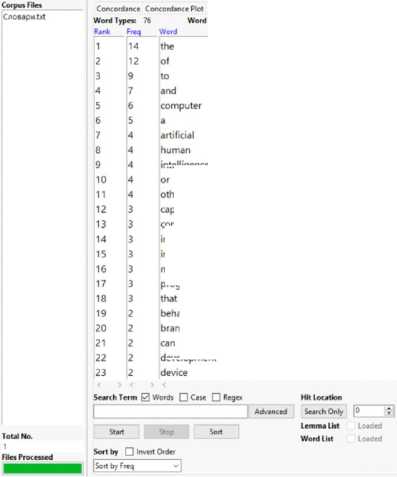
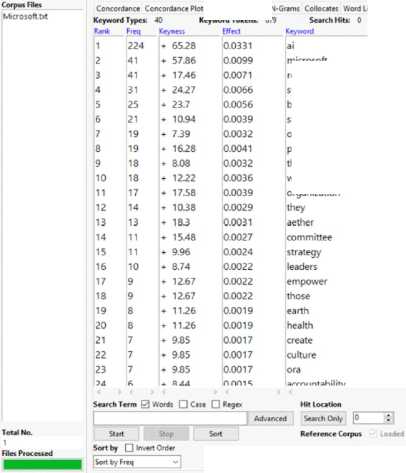



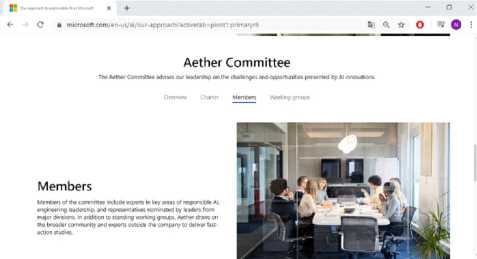
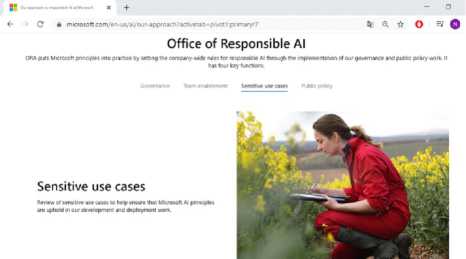

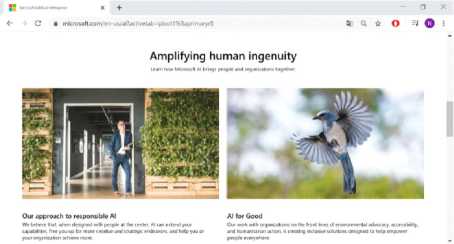
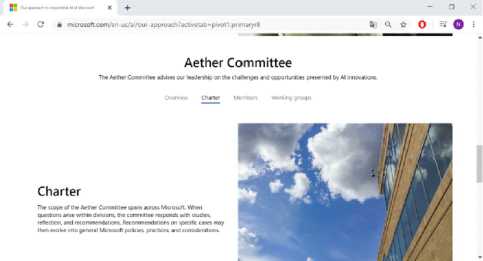
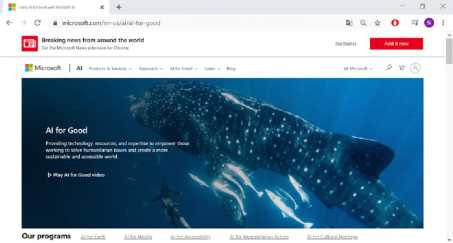


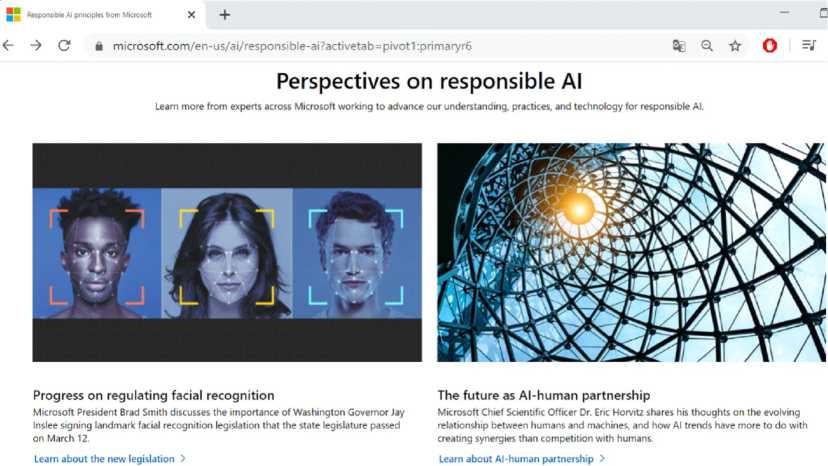

Список литературы The artificial intelligence ideologeme in the multimodal it marketing discourse: a corpus-assisted study
- Bateman J., 2016. From Narrative to Visual Narrative to Audiovisual Narrative: The Multimodal Discourse Theory Connection. 7th Workshop on Computational Models of Narrative (CMN 2016). DOI: 10.4230/OASIcs.CMN.2016.1
- Bi M., 2019. Multimodal Discourse Analysis of News Pictures. Theory and Practice in Language Studies, vol. 9, no. 8, pp. 1035-1039. DOI: 10.17507/tpls.0908.23
- Borisova E.G., 2016. Marketingovaya lingvistika: napravleniya i perspektivy [Marketing Linguistics: Prospects and Trends]. Verhnevolzhskiy filologicheskiy vestnik [Verhnevolzhski Philological Bulletin], no. 4, pp. 140-143.
- Bulakhtina N.A., 2009. Aktualizatsiya kontsepta “kompyuter” v nemetskoy yazykovoy kartine mira: dis. ... kand. filol. nauk [Actualization of the Concept of “Computer” in the German Language Picture of the World. Cand. philol. sci. diss.]. Kemerovo. 218 p.
- Chernyavskaya V.E., 2017. Metodologicheskiye vozmozhnosti diskursivnogo analiza v korpusnoy lingvistike [Towards Methodological Application of Discourse Analysis in Corpus-Driven Linguistics]. Vestnik Tomskogo gosudarstvennogo universiteta [Tomsk State University Journal of Philology], no. 50, pp. 135-148. DOI: 10.17223/19986645/50/9
- Chernyavskaya V.E., 2018. Diskursivnyy analiz i korpusnye metody: neobkhodimoye dokazatelnoye zveno? Obyasnitelnye vozmozhnosti kachestvennogo I kolichestvennogo podkhodov [Discourse Analysis and Corpus Approaches: A Missing Evidence-Based Link? Towards Qualitative and Quantitative Approaches in Language Studies]. Voprosy kognitivnoy lingvistiki [Issues of Cognitive Linguistics], iss. 2, pp. 31-37. DOI: 10.20916/1812- 3228-2018-2-31-37
- Fairclough N., 2003. Analysing Discourse: Textual Analysis for Social Research. London, New York, Routledge. 270 p.
- Klushina N.I., 2008. Intentsionalnye kategorii publitsisticheskogo teksta (na material periodicheskih izdaniy 2000–2008 gg.): dis. ... d-ra filol. nauk [The Intentional Categories of the Publicistic Style (Based on the Material of Periodicals from 2000 to 2008. Dr. philol. sci. diss.]. Moscow. 352 p.
- Klushina N.I., 2012. Intentsionalnyi metod v sovremennoy lingvisticheskoy paradigm [Intentional Method in the Modern Linguistic Paradigm]. Mediastilistika [Media Stylistics], iss. 4. URL: http://mediascope.ru/node/1242
- Klushina N.I., 2016. Diskurs-analiz i stilistika: integrativnye metody issledovaniya media kommunikatsii [Discourse and Stylistics: Integrative Methods of Research of Media Communication]. Russian Journal of Linguistics, vol. 20, no. 4, pp. 78-90.
- Kress G., Leeuwen van Th., 2002. Colour as a Semiotic Mode: Notes for a Grammar of Colour. Visual Communication, vol. 1, iss. 3, pp. 343-368. DOI: 10.1177/147035720200100306
- Kress G., Leeuwen van Th., 2006. Reading Images: The Grammar of Visual Design. New York, Routledge. 312 p.
- Kubryakova E.S., 1995. Evolyutsiya lingvisticheskikh idey vo vtoroy polovine XX veka (opyt paradigmalnogo analiza) [The Evolution of Linguistic Ideas in the Second Half of the 20th Century (Paradigm Analysis)]. Stepanov Yu.S., ed. Yazyk i nauka kontsa XX veka: sb. st. [Language and Science at the End of the 20th Century: Collection of Articles]. Moscow, Russian State University, pp. 144-238.
- Leeuwen van Th., 2013. Colour Schemes. Boeck M., Pachler N., eds. Multimodality and Social Semiosis: Communication, Meaning-Making, and Learning in the Work of Gunther Kress. London, Routledge, pp. 62-71.
- Lylo T., 2017. Ideologeme as a Representative of the Basic Concepts of Ideology in the Media Discourse. Social Communication, vol. 3, iss. 1, pp. 14-20. DOI: 10.1515/sc-2017-0002
- Partington A., 1998. Patterns and Meanings. Amsterdam, Philadelphia, Benjamins. vii, 162 p.
- Pavilenis R.I., 1983. Problema smysla: sovremennyi logiko-filosofskiy analiz yazyka [Problems of Meaning: Modern Logical and Philosophical Analysis of Language]. Moscow, Mysl Publ. 286 p.
- Popova Z.D., 2006. Semantiko-kognitivnyi analiz yazyka [The Semantic-Cognitive Language Analysis]. Voronezh, Istoki Publ. 250 p.
- Popova Z.D., Sternin I.A., 2005. Polevaya model kontsepta [The Field Model of the Concept]. Vvedenie v kognitivnuyu lingvistiku [Introduction to Cognitive Linguistics]. Kemerovo, Kuzbassvuzizdat, pp. 12-43. (Seriya: Kontseptualnye issledovaniya; t. 4 [Series: Conceptual Studies; vol. 4]).
- Samsitova L.Kh., Tashbulatova R.M., 2015. Kontsept v sovermennoy linguisticheskoy literature: Osnovnye podkhody i napravleniya ego izucheniya [The Definition, Approaches and Structure of Concepts in the Modern Linguistic-Themed Literature]. Vestnik Bashkirskogo universiteta, vol. 20, no. 1, pp. 220-225.
- Scott D., 2017. The New Rules of Marketing and PR: How to Use Social Media and Viral Marketing to Reach Buyers Directly. West Sussex, Wiley. 320 p.
- Shutova T.I., 2018. Diskurs protivodeistviya terrorizmu v amerikanskoy politicheskoy ritorike (1972–2012 gg.): dis. ... kand. filol. nauk [The Counter-Terrorism Discourse in the U.S. Political Rhetoric (1972–2012). Cand. philol. sci. diss.]. Nizhny Novgorod. 167 p.
- Usmonova D., 2019. Antropotsentricheskaya model diskursa [Anthropocentric Model of Discourse]. Byulleten nauki i praktiki [Bulletin of Science and Practice], vol. 5, no. 8, pp. 209-217. DOI: 10.33619/2414-2948/45/23
- Wodak R., 2015. Critical Discourse Analysis, Discourse-Historical Approach. Tracy K., Ilie C., Sandel T., eds. The International Encyclopedia of Language and Social Interaction. Chichester, JohnWiley & Sons, Inc., pp. 1-14. DOI: 10.4135/9780857028020.d6

